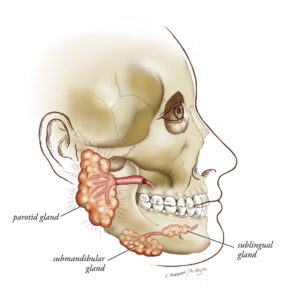Sialendoscopy

M. Allison Ogden, MD of the Sialendoscopy Center at Washington University has been seeing patients since 2009. She is a leader in this technology for the greater St. Louis area and much of the Midwest. Dr. Ogden received her sialendoscopy training in Geneva, Switzerland with Dr. Francis Marchal, who developed the procedure and initiated the development of the instrument set used in partnership with Karl Storz.
Anatomy

Saliva is produced by salivary glands. There are three large major salivary glands on each side and about a thousand small minor salivary glands dispersed throughout the mouth and throat. The larger glands are the parotid, submandibular, and sublingual glands. The saliva is produced in specialized groups of cells within these larger glands and then travels through a duct system to reach the mouth. The parotid gland and submandibular gland both have a branching system that combines into a single large channel (duct) that empties into the mouth in the cheek (parotid) or under the tongue (submandibular). The diagrams to the right show the normal salivary gland anatomy (upper) and the inflamed or blocked salivary ducts (lower).
Obstruction symptoms

Blockage of the flow of saliva is usually caused by stones strictures (narrowing of the duct, or thickened saliva. Blockage can result in pain and swelling from accumulation of saliva within the ducts or gland itself. The swelling can occur suddenly and may be associated with meals. Typically the gland decompresses slowly; this can be helped by gentle massage. A secondary infection of the polled saliva can occur and is generally characterized by pain, overlying skin redness and warmth, thick and/or foul tasting saliva from the duct and possibly fever. Antibiotics are used to treat an infected saliva gland.
Disease processes
Stones occur in ~1% of the adult population, but do not always cause problems. Small stones may pass through the duct opening into the mouth spontaneously. Larger or multiple stones can become stuck (impacted) in the duct system and result in recurrent swelling and/or infections. Strictures of the duct system may result from recurrent or chronic irritation of the glands. Certain diseases, such as Sjogren’s syndrome, can result in changes in the duct system and the gland itself. In addition, radioactive iodine, which is often used as part of the treatment for certain thyroid cancers, can cause injury to the salivary glands and ducts.
Resources
There are several websites where you can learn more about salivary disease obstruction. We have included a few links that we feel have good information. Please remember that information that you read on the website should never refrain you from seeking medical care. Here are just a few helpful links:
ENTtoday: Sialendoscopy on the Brink of Prime Time in the US?
European Sialendoscopy Training Center
New Tools Help Diagnose and Treat Salivary Gland Problems
Appointments
To schedule an appointment with one of our specialists please call: 314-362-7509 or 800-437-5430.